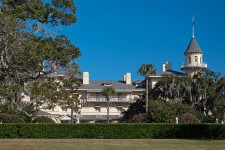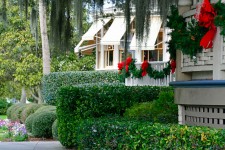Historic District Wall Art
Click Here for More Images
The story of Jekyll and the surrounding islands begins nearly a thousand years ago, when Creek Nation Native Americans occupied the area. They hunted, fished, and used native vegetation for food. Possibly, they grew foods such as maize and beans.
European explorers arrived and in 1510 laid claim to Isla De Ballenas (now Jekyll Island), a name meaning “Whale Island.” The island quickly became disputed land between competing European nations. In 1562, the French explorer Jean Ribault, ignoring Spanish claims, claimed the island (which he called the most pleasant island “of all the world”) for France, renaming it “Ille de la Somme.” Not appreciative of the French insurgents, the Spanish soon defeated Ribault’s forces and executed the Frenchman. Following their victory, the Spanish established a formal colony on Jekyll.
European conflict over Jekyll Island continued, however. The Spanish established Catholic missions in the larger Georgia coastal area and set out to convert the natives to Christianity. Unimpressed, the natives resisted, and for a period of time mounted a campaign to destroy the missions and kill the priests.
Spanish claims were soon contested by the ascendant English, who in the 1660s claimed land from their Jamestown colony in the North to Florida in the South. Allying with major native tribes (Cherokee, Creek and Yuchi), they began an extended war against the Spanish and their native allies, driving the Spanish out of the area by the turn of the 18th century.
 General James Oglethorpe established Georgia as a colony in 1733 and renamed the island Jekyll Island in honor of his friend, Sir Joseph Jekyll. (For much of the 18th and 19th centuries, an incorrect spelling – “Jekyl” – was commonly utilized.) Appointed by Oglethorpe, William Horton oversaw the military defense of the area, and in 1738 built a plantation and assumed permanent residence on Jekyll Island, near present-day DuBignon Creek.
General James Oglethorpe established Georgia as a colony in 1733 and renamed the island Jekyll Island in honor of his friend, Sir Joseph Jekyll. (For much of the 18th and 19th centuries, an incorrect spelling – “Jekyl” – was commonly utilized.) Appointed by Oglethorpe, William Horton oversaw the military defense of the area, and in 1738 built a plantation and assumed permanent residence on Jekyll Island, near present-day DuBignon Creek.
The Spanish, however, returned to the area and attacked British interests, destroying Horton’s home in 1742 before being driven (again) from the area. Horton rebuilt his home as a tabby structure, and ruins of this structure remain to this day.
In 1792, the French returned in the person of the wealthy Christophe du Bignon and his family, who fled the French Revolution. Two years later Du Bignon purchased the entire island from the British, who, following the American Revolution and the establishment of the United States of America, were detaching themselves from their former coastal colonial holdings. Under Du Bignon and his descendants, the plantation and island at large prospered.
Jekyll Island’s prosperity, however, was built upon the labor of slaves, introduced to the island by Du Bignon. Yet slavery proved short-lived on Jekyll. On November 28, 1858, the ship The Wanderer, bearing a cargo of 465 slaves, landed on the island. Christophe’s son Henry, then owner of the Jekyll plantation, played a role in this illegal importation of slaves (slave importation had been banned in the United States in 1808). He and his co-conspirators were eventually tried but acquitted. History would later record this event as the next-to-last successful shipment of slaves to American soil from Africa.
The American Civil War, an armed conflict brought about by divergent American opinions of slavery, impacted the Georgia coast as Union armies occupied much of the region from the early stages of the conflict. Many coastal residents in outlying areas fled, and when Union troops landed on Jekyll in 1862, the island was deserted, the Du Bignon plantation forlorn. After the war, the Du Bignon family returned and Henry, Christopher’s son, divided the island among his four children.
John Eugene du Bignon in the late 1870s assumed ownership of part of the island, and subsequently purchased the remainder of Jekyll from his family. Forming a partnership with his brother-in-law and an investor, the three marketed the island as a winter retreat for wealthy businessmen and their families. They completed construction of a clubhouse in 1888, selling 53 shares for $600 each.
From 1888 until World War II, the club opened each January, with few exceptions, to accommodate the world’s richest families, who built “cottages” (typically 6000sf or more) on the leeward side of the island. During the winter and spring months the wealthy rode bicycles and horses, hunted, played tennis and strolled along the island’s beaches. A small army of island and area residents worked behind the scenes maintaining the residences, cooking food, transporting family members, and otherwise laboring so that members of the millionaire’s club could enjoy the off season on the island.
Yet the Club’s fortunes, tied to financial markets, would not endure. The Great Depression drained the wealth of many members, and in 1942 the Jekyll Island Club closed its doors. Following World War II, the state of Georgia purchased Jekyll Island from the remaining members for the price of $675,000.
Today, many of the Club cottages remain, some in excellent condition. Jekyll Island, a stand-alone state park operated by the Jekyll Island Authority, is now known as “the people’s park.” Largely natural, development on the island includes a few hotels, a water park, some small businesses, and a limited number of residential homes.
Many of the old Club cottages have been restored in recent decades, while the ruins of others remain. Interpretive historical plaques tell the story of the buildings that once comprised the Club. In addition, historians in recent years have begun to focus on the lives of the island residents of the early 20th century who worked behind the scenes.
By legislative mandate, sixty five percent of the island is and will remain in a mostly natural state.




